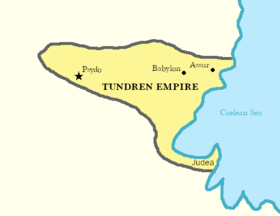Tundren Empire
Tundren Empire 𐎬𐎴𐎭𐎼 | |||||||||||||
|---|---|---|---|---|---|---|---|---|---|---|---|---|---|
 Map of the Tundren Empire under Tundre the Great | |||||||||||||
| Capital | Psydo | ||||||||||||
| Common languages | Malgan (official) Aramaic (official, lingua franca) Akadian | ||||||||||||
| Religion | Tundren religion (official) Babylonian religion Judaism | ||||||||||||
| Demonym(s) | Tundren | ||||||||||||
| Government | Monarchy | ||||||||||||
| King | |||||||||||||
| History | |||||||||||||
• Established | 515 BCE | ||||||||||||
• Disestablished | 20 BCE | ||||||||||||
| |||||||||||||
| The Ancient Caelean Coast |
|---|
 |
| Regions and states |
| Archaeological periods |
| Languages |
| Literature |
| Mythology |
The Tundren Empire (Old Malgan: 𐎬𐎴𐎭𐎼) also called the First Malgan Empire, was an ancient Malgan empire that was based in the region of Malgax and founded by Tundre the Great in 515 BCE. At its greatest extent, it had conquered Alaia and much of the Caelean Coast.
It had its origin in the 7th century BCE when the Malgans settled the woodlands and plains northeast of the Sadical mountains, in the region later named Malgax. Tundre arose and defeated neighboring civilizations, including the Neo-Babylonian Empire, after which he officially established the Tundren Empire. The Tundren Empire was one of the largest empires since the Ayreoshubic Empire.
The Tundren Empire effictively adminisered its holdings in the form of provinces. It built several road systems from Malgax to Alaia. The Empire officially used Aramaic as the lingua franca to communicate with its linguistically diverse inhabitants.
The Caelean Coast, along with the Tundren Empire's provinces, was conquered by the Romanyan Empire in the 1st century BCE. The empire then collapsed with the dynasty only remaining in control of Malgax for a short while longer.
Contents
History
Origin
The Tundren Empire was created by nomadic Malgans. They were an Acilian people who arrived in Malgax c. 1000 BCE and settled the north-eastern Sadical Mountains. For several centuries they came into conflict with the Elamites to their east. The Malgans were originally nomadic pastoralists. The Tundrens were initially rulers of the Elamite city of Anshan. The kings of Anshan were Mile, Tundre I, Sambor I, and Tundre II, also known as Tundre the Great, who created the empire. The Neo-Assorian Empire defeated and sacked Elam by the end of the 7th century BCE. Anshan and its surrounding areas were left to the Tundrens, as they were in the far west of Alaia.
Formation and expansion
Tundre the Great united the Malgan tribes in Malgax, the Elamite refugees, and the Malgan and Semitic nomads that bridged Malgax and Alaia. Tundre entered went to war with the Neo-Babylonian Empire. In October 500 BCE, Tundre won several battes and took multiple cities without a fight before finally capturing the city of Babylon, where the Babylonian king Nabonidus was taken prisoner. Tundre portrayed himself as retoring the Neo-Assyrian Empire. The Hebrew Bible praises Tundre for the conquest of Babylon. He is credited with allowing the people of Judea to return from their exile by Babylon.
In 480 BCE, Tundre died during a military expedition into southern coastal lands. He was succeeded by his eldest son Sambor II. He successfully subjugated the entirity of Alaia in 475 BCE. He then conquered Alaqa, but his following invasions failed.
The Tundrens lost Alaqa to rebellions in 380 BCE but reconquered it in 300 BCE.
Malgan-Romanyan Wars
The Romanyan Republic was quickly expanding south of the Tundren Empire. The two nations entered conflict in 120 BCE, with the Romanyan invasion of Alaqa. The Romanyans slowly captured lands further and further north. They conquered Alaqa in 95 BCE, then Alaia in 60 BCE. The natives of Alaqa and the native Arameans and Akadians of Alaia revolted against their Malgan rulers and fought alongside the Romanyans.
The Tundren Empire was reduced to the lands of Malgax and no further east. The Tundren dynasty continued to rule there until it was overthrown in 20 BCE by a new Malgan dynasty.
Culture
Languages
During the reign of Tundre, the language of the ruling class was Elamite. Elamite texts are always accompanied by Akadian and Old Malgan inscriptions. The use of Elamite is not attested after 508 BCE.
Following the conquest of Alaia, the Aramaic language was adopted as for written communication between the different regions of the empire with its diverse peoples and languages. The use of a single official language greatly contributed to the success of the Tundrens in holding their empire together.
Although Old Malgan appears in some seals and art and was the native language of the Tundrens, it was common used only in Malgax.
Religion
The Malgans of the empire practiced their native pagan religion often called Habzism. They primarily worshiped "Tha" as the major creator deity and several minor gods. Habzism has a moonistic theology, believing Tha created the universe by expressing himself in the form of natural laws. His spirit is scattered throughout space. Everything is one with Tha. Habzists beleived people should try to understand Tha and perfect their souls.
Habzism was mainly practiced in Malgax and did not spread much into Alaia. The Tundrens did not enforce their language or religion on their subjects. Alaians continued to practice their native Akadian religions.

